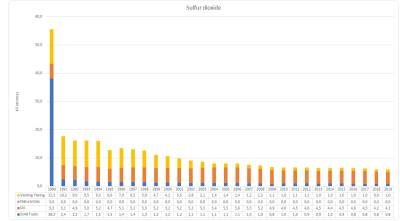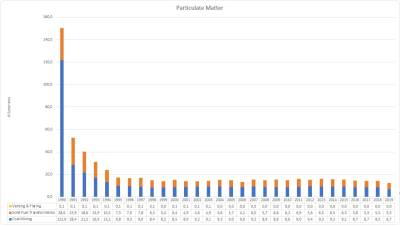meta data for this page
This is an old revision of the document!
1.B - Fugitive Emissions from fossil fuels
During all stages of fuel production and use, from extraction of fossil fuels to their final use, fuel components can escape or be released as fugitive emissions.
While NMVOC, TSP and SOₓ are the most important emissions within the source category solid fuels, fugitive emissions of oil and natural gas include substantial amounts of NMVOC and SOₓ.
1.B - “Fugitive emission from fuels” consist of following sub-categories:
| NFR-Code | Name of category |
|---|---|
| 1.B.1 | Solid Fuels |
| 1.B.2.a | Oil |
| 1.B.2.b | Gas |
| 1.B.2.c | Venting and Flaring |
| 1.B.3 | Geothermal Energy |
Trends in emissions
Sulphur Dioxide emissions occur during the production of hard-coal coke. The value of the year 1990 is partly based on the GDR’s emission report, chapter “Produktion” (=production) which has no clear differentiation between mining, transformation and handling of coal. The total emission as reported in the emission report is allocated in the NFR categories 1.B.1 and 2. The split factor is based on estimation of experts. The apparently steep decline from 2007 to 2008 is the result of a research project in 2010, where new emission factors were determined for coke production for the years 2008.
Particulate matter emissions occur during the transformation of lignite and hard coal. The very steep decline of the emissions in the early 1990s is due to the shrinking production of lignite briquettes (almost 90% in the first five years). The value of the year 1990 is partly based on the GDR’s emission report, chapter “Produktion” (=production) which has no clear differentiation between mining, transformation and handling of lignite. The total emission as reported in the emission report is allocated in the NFR categories 1.B.1 and 2. The split factor is based on estimation of experts.
NMVOC emission occur during the production of hard-coal coke. The shrinking emissions are mainly attributed to the hard-coal coke production and the decommissioning of outdated plants.
Carbon monoxide emissions occur during the production of coke and charcoal. The rising emissions are mainly attributed to the increasing production of charcoal and coke. A trend-reversing issue was the decommissioning of outdated plants in the 1990s.
Recalculations
Recalculations covering the past two years have been carried out as a result of the provisional nature of a number of statistics in this area.
Furthermore, some minor changes in activity data for distribution of mineral oil products led to marginal changes in NMVOC emissions.
| NMVOC | Unit | 1990 | 1995 | 2000 | 2005 | 2010 | 2015 | 2018 |
|---|---|---|---|---|---|---|---|---|
| 2020 Submission | kt | 183,50 | 124,68 | 84,95 | 54,21 | 44,48 | 40,68 | 40,06 |
| 2021 Submission | kt | 183,47 | 124,85 | 84,91 | 54,18 | 44,35 | 40,59 | 39,93 |
| Difference | kt | 0,03 | -0,17 | 0,04 | 0,03 | 0,13 | 0,09 | 0,13 |
For pollutant-specific information on recalculated emission estimates reported for Base Year and 2015, please see the pollutant specific recalculation tables following chapter Chapter 8.1 - Recalculations].
Improvements planned for future submissions
- emissions from storage of refinery products will be divided up to fuels (under 1.B) and chemical products (2.B)
- emission factors from natural gas transmission will be updated according to results of the UNEP OGMP 2.0 measurement programm (1.B.2.b.iv)





